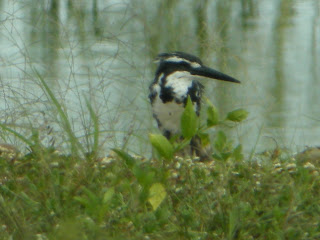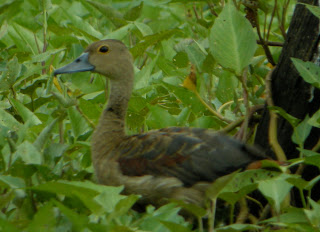Sharp-tailed sandpiper
Calidris acuminata
นกชายเลนกระหม่อมแดง
Khok Kham 20.09.10
I was going to write to you about my buffoonery, I have recently hit a rich seem of it, but the real story is the presence today of a sharp tailed sandpiper at Khok Kham viewed by Mr Dtee, Tom Baclund and myself this afternoon. Of course we were there with spoon-billed sandpiper on our minds but he didn't show and Mr Dtee, despite heroic efforts, could not sniff him out. This sharp-tailed sandpiper is a lifer for me and I count myself lucky to have seen and photographed the bird. Likely to have originated in the north of Siberia and may stay here or may be on its way further south, common in Australia and New Zealand during the northern winter.
Buffoonery Part 1: I managed to leave my Hoodman Loupe at home hence most of my photographs today are not brilliantly focused plus I was working in strong sunlight. The Hoodman is a perfect solution for these issues and I went to a lot of trouble and expense to get one!
Pacific golden plover
Pluvialis fulva
นกหัวโตหลังจุดสีทอง
Khok Kham 20.09.10
Next a very common bird but a real treat for the eyes, a pacific golden plover, male, in breeding plumage, well in fact it is in moult. Nevertheless a very striking bird on the eye, looks a bit like a pearly Cockney, sorry me ol' Chinas from the Smoke.
Buffoonery runs to several parts including two broken cable shutter releases, leaving my shutter release bracket at home yesterday, an Australasian Bushlark which I corrected to a Paddyfield Pipit.......and the latter is probably the best photograph I have take using the digiscope rig!
Paddyfield pipit
Anthus rufulus
นกเด้าดินทุ่งเล็ก
Huai Mai Teng Reservoir 19.09.10
So notwithstanding the buffoonery my digiscoping skills are improving. The paddyfield pip shows what the potential is. I missed some great shots because of my buffoonery, a little grebe with her two grebelets sprawled on her back, a picture of absolute contentment and devotion.......all badly out of focus. Such is life!
Finally the River Lapwing was back in the local rice paddy on Sunday evening but not at lunch time today.













































